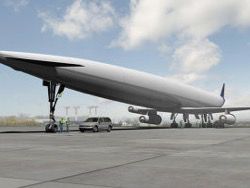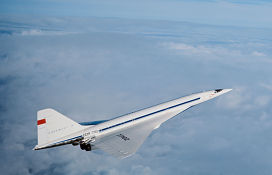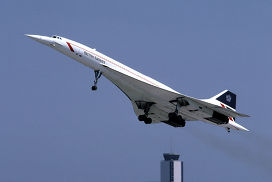How to construct a hyper sound airliner

Probably, the passenger plane, capable to overcome a route of any extent less than in three hours, becomes reality by 2030, the correspondent of BBC Future came to a conclusion.
«It is the magic plane… from flight on it you receive almost physical pleasure», – so the stewardess of Air France airline Dzhoel Korn-Temple once expressed the British-French Concorde – one of first-ever supersonic airliners who was in operation from 1976 to 2003 and became a symbol of stylish travel.
Concorde overcame distance between London and Sydney in 17 hours, three minutes and 45 seconds – for comparison, flight on Boeing 747 on the same route took about 22 hours.
Supersonic passenger plane less known in the world, the Soviet Tu-144, was in operation till 1999.
After the completion of cold war one of Tu-144 options was used in interests of the American NASA space agency, and also as flight laboratory within the joint Russian-American research program on creation of new generation of supersonic aircraft of civil appointment.

With a conclusion from operation both market of supersonic passenger traffic became empty. Now, 12 years later after the termination of regular flights of Concorde, at once some design offices work over creation of even more high-speed planes.
One of such projects – the II European Lapcat within which it is planned to create at once two supersonic liners.
And one of them should gather cruiser speed in 8500 km/h, that is in 8 times speeds of a sound that will allow it to transport passengers between Brussels and Sydney in 2 hours of 55 minutes are higher.
The team of developers of Lapcat II presented the report at the July conference devoted to suborbital aircraft both hyper sound systems and technologies, carried out by the American institute of aeronautics and astronautics in the Scottish Glasgow.
According to them, results of a series of preliminary tests specify that this development will be more harmless, than existing passenger planes, not less safe and not much more expensive in operation, than present long-haul liners.
What fuel to choose?
The employee of the European space agency (EKA) Johan Stilant coordinates the Lapcat II program.
Within Lapcat II two projects are in parallel developed. One of them – Lapcat A2, capable to gather the speed corresponding to number of the Move 5 (М=5).
It will be equipped with the hybrid propulsion jet/rocket engine with preliminary cooling of Scimitar.
Other plane in which development EKA is engaged directly, will use the hyper sound direct-flow propulsion jet engine. Its cruiser speed, as expected, will correspond М=8.
As an oxidizer in the direct-flow propulsion jet engine (PVRD) zabortny air is used: the high-speed running air stream getting to an air inlet, is compressed and moves in the combustion chamber.
Rockets by which the European fighter Eurofighter Typhoon is armed work at this principle, for example.
The plane equipped with PVRD, is capable to gather very high speed. But hyper sound engines of the future should work at what fuel?
It is very important question, considering that one of a determinant at creation of superfast airliners is need as much as possible to lower level of harmful emissions.
For this reason of EKA chose hydrogen which is more non-polluting, than hydrocarbonic types of fuel.
Besides, though also it is possible to set fire to liquid hydrogen, it ignites not so easily, as kerosene (standard fuel of modern airliners), therefore risk of explosion or a fire onboard essentially below. Engines of space shuttles of NASA, for example, worked at liquid hydrogen «the Space Shatl».
«Unlike kerosene, liquid hydrogen at hit in the atmosphere instantly evaporates. Therefore in case of leak on parking under plane pools of the flowed-out fuel will not be formed, – tells Stilant. – As well as for ignition heat source therefore combustion is excluded» is necessary to kerosene, hydrogen.
Lapcat II – not the unique existing program of development of the superfast plane. EKA exchanges knowledge and technologies with Japanese agency of the space researches JAXA within the joint Japanese-European Hikari project.
JAXA works over creation of a hyper sound airliner under the name Hytex which, as expected, will be capable to cross the Pacific Ocean in two hours with a speed М=2.
During tests in a wind tunnel Hytex turbojet already reached speeds in М=1,8. The engine uses liquid hydrogen both as fuel, and as a cooler when flying on hyper sound speeds.
«We finished formation of shape of Hytex and executed a series of purges in a wind tunnel. Fuel consumption will make one fifth that rocket engines» spend, – marks out Hideyuki Taguchi, the leading expert of JAXA in the direction of hyper high-speed aviation equipment.
Where to take hydrogen?
The main problem explaining high potential cost of operation of hyper sound planes, there is a low efficiency of an existing way of receiving hydrogen.
If hydrogen took from natural gas, instead of received by water electrolysis, the price of the ticket for hyper sound flight could make about a half from today’s cost of the ticket in a business class.
And when using present technology of production of hydrogen the ticket aboard the plane the future, according to forecasts, will manage on the average approximately three times more expensively than the ticket of a business class for a modern subsonic airliner.
So, for the one way ticket from Brussels to Sydney it is necessary to pay 5000 euros.
How more effectively to extract hydrogen in necessary quantities?
«It is possible to turn the electric power developed by vetroelektrostantsiya into hydrogen, – considers Stilant. – This principle is already realized by one of the Belgian networks of supermarkets – its shops are equipped with the wind-driven generators developing hydrogen at which vilochny loaders» work.
Unlike modern subsonic planes, the airliners working at hydrogen, will not release into the atmosphere the substances strengthening greenhouse effect, such as carbon dioxide, oxides of sulfur and soot.
However hydrogen engines have the shortcoming: in the course of their work water vapor which for a long time remain in a stratosphere are formed and can serve its purpose in the course of global warming.
And emissions, obrazuyemy at hydrogen combustion, are capable to appear even more pernicious for climate as they dissipate really very long.
«We still should study in more detail the mechanism of this process», – notes Stilant.
Carried out before research showed that the period of dispersion of water vapor is exponential reduced at increase in height: at height in 25 km it can make 30 years, and at the heights exceeding 32-34 km – less than a year«.
Developers of the Lapcat II plane, capable to gather speed М=8, plan that it will fly on echelons much above 33 km that as they count, will reduce harmful effects on environment.
The liquefied natural gas – for example, the overcooled methane which at storage in a liquid state occupies much smaller volume, than in the gaseous could become alternative to hydrogen.
«It can begin formation of the market of hyper sound business aircraft», – tells Stilant.
What to do with sound blow?
Over creation of such market other companies already work. The European producer of Airbus patented recently the concept of the hyper sound aircraft with the deltoid wing, capable to gather speed М=4,5. This concept could be used for creation of business planes.
Airbus also works – together with the American startup of Aerion – over creation of supersonic jet planes for the provided clients.
One more American company, Spike Aerospace, plans to create supersonic business джет at which the role of windows will be played located on salon boards by screens – the image on them will move from external video cameras.
And the defensive producer of Lockheed Martin works over the civil N+2 plane, capable to fly with a speed М=1,7.
However on such high speeds of flight there is one more problem – influence of the sound blow caused by a shock wave from the plane, moving with supersonic speed.
Loudness of the sound blow reaching lands, can reach 160 dB – enough to lead to irreversible loss of hearing.

The sound blow fixed on the earth from Concorde flying on a supersound made 135 dB – much more loudly, than on the average the noise made by subsonic airliners.
Hyper sound planes should fly between Europe and America through the North Pole, prolagy a route far from the occupied district.
Even more loudly sound blow at change of speed or maneuvering. And loudness of reaching earth of a shock wave in this case in two or three times is higher, than at height on which the plane flies by.
However, as the European hyper sound plane will fly above usual airliners, the square of sound blow at districts will appear more, and its loudness – below.
NASA together with Lockheed Martin and Boeing investigates possibilities of decrease in effect from the sound blow made by superfast planes. It is not excluded that by 2020-2025 it will be possible to develop the aircrafts, capable to break a sound barrier over the occupied areas, without creating inconveniences to locals.
Meanwhile in Europe team Stilanta blew in a wind tunnel model of the 300-seater hyper sound plane on the scale of 1:120 for the speed М=8.
Tests confirmed ability of the plane to create positive draft. Though it also will spend twice more fuel, than the projected airliner gathering speed М=4, the economy of time in a way will make about 50 % so on the same route both planes will need approximately identical amount of fuel.
How to win a heating problem?
One more problem which should be solved, is a heating of external surfaces of the hyper sound plane: when flying on speeds from М=5 and above the temperature of its covering will reach 1000°C.
Aluminum and the titan at such temperatures melt, like oil. It is necessary to use ceramic materials.
During purges for the speed М=8 the surface of model heated up to temperature approximately for 30 % below, than for the speed М=5.
This paradox became a pleasant surprise for team Stilanta who presented results of tests for conferences in Glasgow.
«The mass of the thermosheeting demanded for the aircraft, flying for the speed М=8, can be lower, than for the plane flying on М=5. The plane is easier, the fuel consumption is lower; respectively, the volume of fuel tanks, and it decreases, in turn, conducts to even bigger simplification of a design», – tells Stilant.
The team of the Japanese engineers working over the Hytex project, studied the potential market of hyper sound airliners with cruiser speed М=5 and came to a conclusion that the 100-seater option, capable to carry out two turnaround flights in a day (that is only four flights from take-off before landing) would become the most demanded.
The people who are interested in the unusual ways of movement and ready to pay the sum equivalent to the today’s first class ticket would be passengers generally.
According to the research which has been carried out by Airbus and Japanese Japan Aircraft Development Corporation, by 2030 cost of a segment of hyper sound aircraft industry can make 3,5 billion euro, and number of the personnel occupied in it – to exceed 500 000 people.
«The predicted price of the ticket for flight from Tokyo to Los Angeles would be comparable with cost of the present first class ticket on the same direction», – tells Taguchi.
Thus, hyper sound flights would appear to available about 10 percent of all air passengers – that is that who has possibility and desire to pay for more high-speed flights.
Airbus and Aerion will start to test the development in 2019. On completion of work on Lapcat A2 (gathering speed М=5) it can be demanded about 20 more years, and the Lapcat project with a speed М=8, probably, becomes commercially paid back somewhere in the middle of the current century
Adrian Dzhiordani










